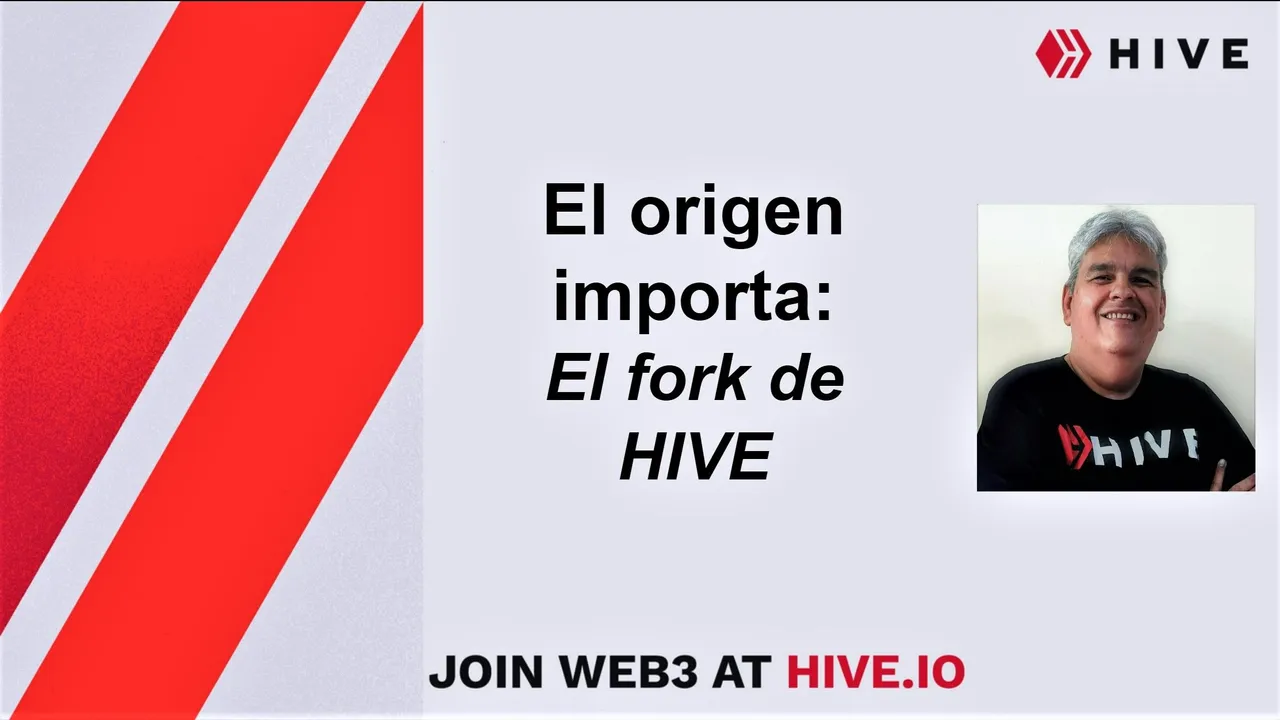Antier, al finalizar la tarde, tuvimos visita en casa. Éstas personas fueron invitadas por mi esposa para una charla sobre como construir en Web3 y, por extensión, en HIVE. En el vendaval de pensamientos que vinieron a mi cabeza luego de la experiencia, reparé en algo poco documentado a pesar de ser muy importante: El origen de HIVE. Y como parte del proceso para preparar nuestro viaje al Cripto Latin Fest es refrescar conceptos para responder preguntas al público, creí necesario refrescar el origen de nuestra comunidad propietaria.
De ésta manera: @sherescolche, @kwarkyria, @catirusia, @caravan208 y @clodie, tendrían de primera mano algo para comprender como se tejió el nacimiento de nuestro ecosistema. Aunque todos sitúan la fecha 20 de Marzo de 2020 como el día que se validó el primer bloque de HIVE, la historia se remonta muy atrás en el tiempo. Desde el mismo momento cuando un par de desarrolladores de Steem aprovecharon a escondidas una brecha informativa, con el fin de ejecutar un minado Ninja de la nueva blockchain (se le dice minado ninja a una reserva de tokens que se guarda para vender a futuro, si el precio del mismo se infla en el mercado). En ese instante se creó una bomba de tiempo que explotaría años más tarde.
ENGLISH VERSION (click here!)
The day before yesterday, late in the afternoon, we had a visitor at home. These people were invited by my wife for a talk on how to build in Web3 and, by extension, in HIVE. In the gale of thoughts that came to my head after the experience, I noticed something little documented yet very important: The origin of HIVE. And as part of the process to prepare our trip to the Cripto Latin Fest is to refresh concepts to answer questions to the public, I thought it was necessary to refresh the origin of our proprietary community.
This way: @sherescolche, @kwarkyria, @catirusia, @caravan208, and @clodie, would have first-hand something to understand how the birth of our ecosystem was woven. Although everyone places the date March 20, 2020, as the day the first HIVE block was validated, the story goes way back in time. From the very moment when a couple of Steem developers sneakily took advantage of an information breach, to execute a Ninja mining of the new blockchain (Ninja mining is said to be a stockpile of tokens that is kept to sell in the future if the price of the token is inflated in the market). In that instant a time bomb was created that would explode years later.

Diseño de portada en Google Documents por @fermionico, fondo cortesía de @hivecreators
Google Documents cover design by @fermionico, theme courtesy of @hivecreators

Corría el año 2016 y la promesa de Ned Scott, además de Dan Larimer fue jamás vender ese preminado. Lo usarían con el tiempo para apuntalar el crecimiento de la cadena, usándolo como fondo de desarrollo. En el papel, la promesa estaba hecha y la comunidad fue calmada cuando las preguntas habían comenzado. Más adelante en el tiempo, Justin Sun, creador de la blockchain TRON andaba de cacería para invertir en una cadena que le aportara valor a su comunidad gaming. SteemMonsters se había convertido en el juego NFT número uno entre los proyectos blockchain y corría en Steem.
Los creadores del juego buscaban asociaciones para llevar más allá de Steem el exitoso juego. Justin vió una oportunidad sin saber que había detrás del potencial en las redes sociales que corrían en la antigua cadena (Steem), ambas cadenas se asociaron en el último trimestre de 2019 y los usuarios de TRON podían comprar cartas del juego y correr la aplicación como si fuera nativa. En el interín, Sun se dio cuenta que podía unir ambas cadenas si ofrecía dinero por el minado Ninja. Dan Larimer se había retirado hacia tiempo, pero Ned Scott lidiaba con la gobernanza de Steem quienes no comprendían porqué se dilataban los proyectos de desarrollo. Y sucedió lo inesperado: Ned rompe la promesa y vende el minado Ninja de Steem a Justin Sun.
ENGLISH VERSION (click here!)
It was 2016 and Ned Scott's promise, as well as Dan Larimer's, was to never sell that premining. They would use it over time to prop up the growth of the chain, using it as a development fund. On paper, the promise was made and the community was quieted when the questions had begun. Later, Justin Sun, creator of the TRON blockchain was on the hunt to invest in a blockchain that would bring value to his gaming community. SteemMonsters had become the number one NFT game among blockchain projects and was running on Steem.
The creators of the game were looking for partnerships to take the successful game beyond Steem. Justin saw an opportunity without knowing what was behind the potential of social media running on the old network (Steem), both networks partnered in the last quarter of 2019 and TRON users could buy cards from the game and run the app as if it were native. In the interim, Sun realized it could merge the two chains if it offered money for Ninja mining. Dan Larimer had long since retired, but Ned Scott was dealing with Steem's governance who didn't understand why development projects were dragging on. And the unexpected happened: Ned broke the promise and sold Steem's Ninja mining to Justin Sun.


A partir de la venta los eventos se precipitaron uno tras otro. La comunidad se encontraba confundida y en un AMA (Ask me everything), Justin respondió a la pregunta de los testigos de consenso sobre el futuro de Steem, que uniría ambas blockchain. Como era de esperarse, a los testigos de consenso no les gustó lo que a simple vista era un intento de centralización. Siendo lo contrario una filosofía básica en Web3, los testigos decidieron correr un Fork (actualización) donde se congelaba el minado Ninja hasta que Justin entrara en razón y se reuniera con la comunidad.
El sistema de gobernanza DPOS (Decentralized Proof of Stake) fue puesto a prueba porque Justin, ayudado por varias exchange, compró tokens para elegir testigos de consenso falsos (Puppets witnesses) con el fin de correr un fork para descongelar el minado ninja. El asiático tuvo éxito y de seguidas, toda la comunidad reaccionó para votar los testigos de consenso legales y apoyar la posición de descentralización. La guerra llegó a un punto muerto cuando de los 20 testigos, 10 estaban del lado centralizado y 10 en contra. En medio de la pelea, los exchanges se arrepintieron de haber usado los tokens resguardados para influir en la gobernanza y decidieron abandonar la pelea.
ENGLISH VERSION (click here!)
From the sale onwards events rushed one after the other. The community was confused and in an AMA (Ask me everything), Justin answered the question from consensus witnesses about the future of Steem, which would unite both blockchains. As expected, the consensus witnesses did not like what at first glance was an attempt at centralization. The opposite being a basic philosophy in Web3, the witnesses decided to run a Fork (update) where Ninja mining was frozen until Justin came to his senses and met with the community.
The DPOS (Decentralized Proof of Stake) governance system was put to the test because Justin, helped by several exchanges, bought tokens to elect fake consensus witnesses (Puppets witnesses) to run a fork to unfreeze ninja mining. The Asian succeeded and immediately, the whole community reacted to vote for legal consensus witnesses and support the decentralization position. The war came to a stalemate when out of 20 witnesses, 10 were on the centralized side, and 10 against. In the midst of the fight, the exchanges regretted having used the guarded tokens to influence governance and decided to abandon the fight.


Tal acción entregó la brecha necesaria para ganar la gobernanza por mayoría simple y el 20 de Marzo de 2020, los testigos de consenso decidieron imprimir el bloque génesis de HIVE. Es importante acotar varias cuestiones a partir de allí. La experiencia acumulada por la comunidad, viene de mucho más atrás en el tiempo, de allí el alto valor que se desprendía con la separación (fork). Otra de las consecuencias ha sido registrar el primer intento exitoso de una gobernanza DPOS al separar dos cadenas y hacer que la cadena hija sea mucho más valiosa que la cadena madre (ésto se puede verificar mediante el valor del token en el mercado).
Muchos de los males que acompañaban a Steem fueron puestos de lado. Disminuyó el plagio, la compra de votos, aumentaron las recompensas de curación, mejoraron las recompensas de los creadores de contenido, se consolidaron las comunidades y un montón de vicios desaparecieron. Hoy día miramos el mañana con mucha esperanza. Al desaparecer el minado Ninja y convertirlo en el fondo de desarrollo que siempre habíamos luchado, podemos crecer sin miedo a otra compra hostil. Porque de la guerra se aprendió y varias condiciones que ponían en peligro la gobernanza desaparecieron. Quien no conoce su pasado no puede construir su futuro.
ENGLISH VERSION (click here!)
Such action delivered the necessary breakthrough to win governance by a simple majority and on March 20, 2020, the consensus witnesses decided to print the genesis block of HIVE. It is important to note several issues from this point on. The experience accumulated by the community comes from much further back in time, hence the high value that came with the separation (fork). Another consequence has been to record the first successful attempt at DPOS governance by separating two chains and making the daughter chain much more valuable than the mother chain (this can be verified by the value of the token in the market).
Many of the evils that accompanied Steem were put aside. Plagiarism decreased, vote buying decreased, healing rewards increased, content creator rewards improved, communities were consolidated and a lot of vices disappeared. Today we look to tomorrow with a lot of hope. With Ninja mining gone and turned into the development background we had always fought for, we can grow without fear of another hostile takeover. Because of the war, we learned that several conditions that endangered governance disappeared. He who does not know his past cannot build his future.

Translated DeepL
The images have imbued sources and have been intervened.




